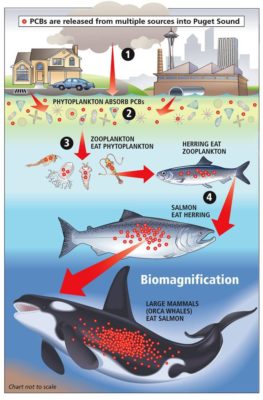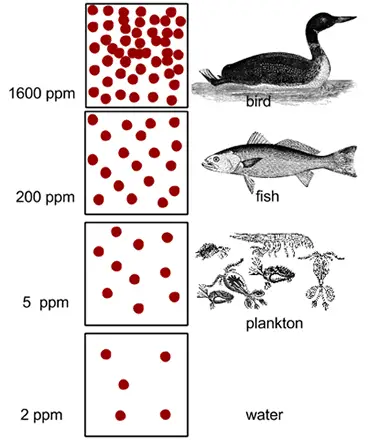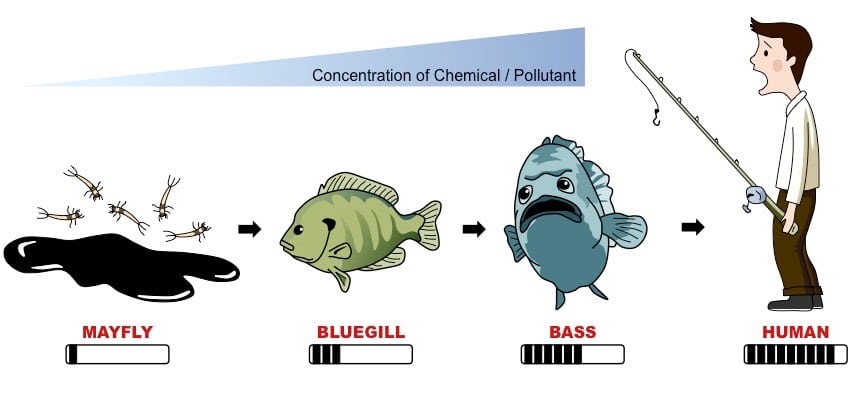Using an Example Describe the Process of Biomagnification
Phytoplankton refers to small plants that float in the seas that normally absorb toxins. That is an example of Biomagnification.

Bioaccumulation And Biomagnification Problems
An apt example of biomagnification will be when small fish eat contaminated microscopic organisms and big fish eat the small fish.

. The meaning of BIOMAGNIFICATION is the process by which a compound such as a pollutant or pesticide increases its concentration in the tissues of organisms as it travels up the food chain. A Real-Life Example of Biomagnification When a marsh is sprayed to control mosquitoes it releases a trace amount of DDT. When mixed with water it accumulates.
One of the most common examples of biomagnification is algal bloom that often leads to red tide. Each small fish consumes ten times their weight in. Biomagnification can be defined as the rise or increase in the contaminated substances caused by the intoxicating environment.
How to use biomagnification in a sentence. Here are a few real-life examples of Biomagnification Example 1. Biomagnification takes place as chemicals transfer from lower trophic levels to higher trophic levels within a food web resulting in a.
Explain bioaccumulation and biomagnification with examples. Here are a few examples. When pesticide are sprayed to control mosquitoes a trace amount of DDT is released which gets accumulated in the cells of.
These small organisms are often eaten by fish which might be eaten by bigger fish birds animals or humans. Various examinations in different research centres confirm that COVID-19 is a result of environmental degradation. Once feeders up the food chain such as clams and fishes eat these organisms they consume that DDT.
An example of biomagnification occurs on some sites in semiarid regions. As a result of soil contamination the process of biomagnification may occur. The contaminants might be heavy metals such as mercury arsenic and pesticides such as polychlorinated biphenyls and DDT.
Biomagnification also requires movement up a food chain in order to occur while bioaccumulation does not require that the animal be eaten. Drouillard in Encyclopedia of Ecology 2008. And the concentration of these substances keeps increasing as they move up the chain.
Many of these studies also demonstrate the potential negative consequences of this build up over time. Biomagnification refers to the condition where the chemical concentration in an organism exceeds the concentration of its food when the major exposure route occurs from the organisms diet. At the bottom of the food chain plankton are infected with mercury often through diffusion with the surrounding water and eaten by some small fish to greatly simplify things assume that each plankton has a concentration of 1 ppm of mercury in it.
So first the pollutants are transferred from microscopic organisms to the small fish that feed on them and then to the big fish that feed on these small fish. Disruption of The Food Chain. Biomagnification refers to the tendency of pollutants to concentrate as they move from one trophic level to the next.
The most common example of biomagnification is the ongoing COVID-19 situation. 01122022 Create an account. There are numerous well-documented examples of biomagnification where researchers find high concentrations of chemicals in apex predators.
Spraying a marsh to control mosquitoes will cause trace amounts of DDT to accumulate in the cells of microscopic aquatic organisms the plankton in the marsh. Biological magnification often refers to the process whereby certain substances such as pesticides or heavy metals work their way into lakes rivers and the ocean and then move up the food chain in progressively greater concentrations as they are incorporated into the diet of aquatic organisms such as zooplankton which in turn are eaten perhaps by fish which then. In this case excessive amounts of chemicals presumed by the organism as a nutrient cause the overgrowth of the alga known as Karenia brevis.
Discover how these chemicals can concentrate in the tissues of living organisms with each step in the food change and explore some examples of biomagnification. The process begins with the release of toxic chemicals. In such cases there may be hyperaccumulation of this selenium compound by specialized plant species.
The soil in these regions is contaminated by selenium. Examples of Biological Magnification. Biomagnification occurs when slightly larger organisms called zooplankton feed upon the contaminated phytoplankton and in turn absorb POPs into their own tissues at a higher concentration.
Process of Biomagnification Release of toxic chemicals and pollutants into the environment. The concentration effect occurs because DDT is metabolized and excreted much more slowly than the nutrients that are passed from one trophic level to the next. Phytoremediation mycoremediation bioinventing biobleaching landfarming biorector composting bioaugmentation rhizofiltration biostimulation are all examples of Bioremediation.
The figure shows how DDT becomes concentrated in the tissues of organisms representing four successive trophic levels in a food chain. Real-Life Examples of Biomagnification. Biomagnification can be considered the result of bioaccumulation.
The more contaminated phytoplankton a zooplankton eats the more pollutants it will have in its body. The process occurs when a chemical or metal becomes increasingly concentrated as it moves up through a food chain that is the dietary linkages between single-celled plants and increasingly larger animal species. How DDT becomes concentrated as it passes through a food chain.
Food chain disruption is one of the major effects of biomagnification as it has a high impact on our ecosystem. These substances are taken up by the organisms through the food they consume. When pesticides or heavy metal go the ocean they get incorporated into the diet of the small ocean organisms.
Bioaccumulation takes place in a single organism over the span of its life resulting in a higher concentration in older individuals. This alga which is color red due to the pigment xanthophyll is capable of producing a certain kind of neurotoxin that can be. The term food web biomagnification is used to describe trophic enrichment of contaminants within food webs.
Bioaccumulation refers to the entry of a pollutant or toxic substance in the food chain whereas biomagnification refers to the increase in concentration of a toxic substance at each successive trophic level after entering into food chain.

Bioaccumulation Biomagnification When Bigger Isn T Better Shark Research Conservation Program Src University Of Miami


0 Response to "Using an Example Describe the Process of Biomagnification"
Post a Comment